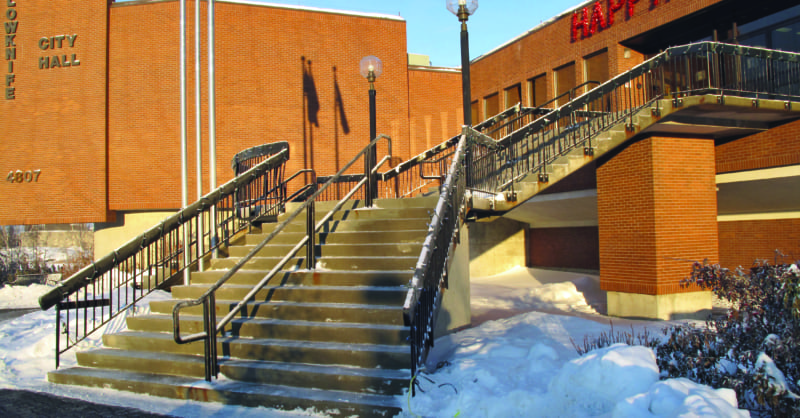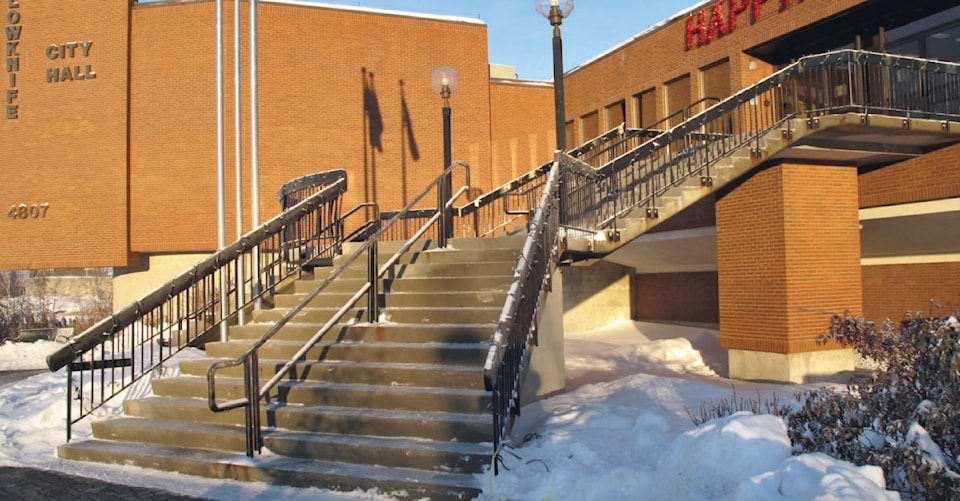I think every community in the land needs a book of knowledge. One where they can list mistakes, big and small. Then, hopefully people will read the book occasionally and not make the same mistake over and over again.
I would like to nominate the city hall steps for inclusion into the book because the city plans to spend $365,000 dollars to replace them. They are crumbling, and the rebar supports are rusting and this has been going on since they were first installed.

NNSL file photo
The problem is, we live in a winter city where you can expect at least six months of snow. Every time it snows, one or two city workers have to go out and shovel them. Add it up and those steps cost the city a fair bit in maintenance every year.
Also, when the steps get icy and slippery, they put salt on them. That salt melts the ice and creates salty water which seeps into the concrete and begins to dissolve or eat it. That combined with a bunch of freeze and thaw cycles, creates cracks and pieces of the concrete slough off. So, you have chemical and mechanical weathering taking place. The steps are literal crumbling away.
Also, when that salty water comes into contact with the steel reinforcement bars buried in the concrete, they begin to rust and corrode. They are oxidizing and slowly burning away, and this weakens the entire structure.
I seem to recall several past repairs to the steps because of this. It seemed to happen every five or 10 years. Those were expensive repairs and you can see those steps have cost the city a whole lot of money. Add up the cost of shovelling snow off them all winter long, the cost of periodically repairing them and now the cost of completely replacing them and you can see those steps have cost taxpayers a whole lot of money.
So why do we even have them?
That is a very good question and it has to do with the way the building was designed, and it certainly wasn't designed for our Northern climate. Just go and stand in front of city hall some day and contemplate the building and you will see what I mean.
The places where you go to do business are all on the second floor. That's where you pay bills, tickets and fines, get permits and attend the occasional council meeting. So, to get there they put in the grand stairway. This use to be a fad for big public buildings and it was meant to send several signals to people. One was "Look at us. We are big, important, powerful and you have to climb a whole bunch of steps up, if you want to talk to us." I call it the Mount Olympus syndrome. If you want to talk to the gods, you must climb the mountain.
Here is another little bit of history to show how poorly the building was designed. At some point after the original design came in, someone asked "How the heck, are handicapped or disabled people, supposed to get in?" This caused panic and eventually they stuck in an elevator, very much as a last-minute addition. From the second floor it is not that hard to find but if you go down to the first floor you are in a maze of narrow hallways that twists and turns seemingly at random until you find through the labyrinth. Then you exit via the ground level door, which many people don't even know exists.
So personally, I think the stairs should make it into the book of knowledge and hopefully the new stairs will be built to solve some of the problems that destroyed the first set.
Also, I think the whole city hall building, should go into the book of how not build things in the North. That building has cost taxpayers a lot of money with leaky roofs, renovations and repairs often because it has a lousy design. It really is time we started putting up buildings designed for our climate and to serve the population better. Sooner or later, maybe we will learn.
I live in hope.
